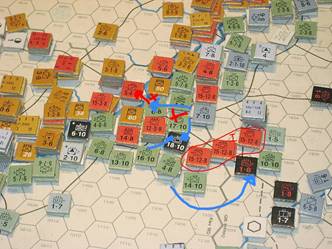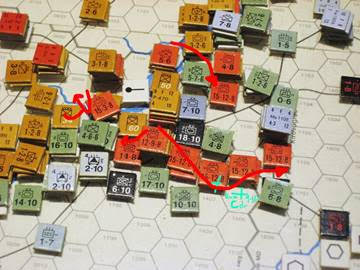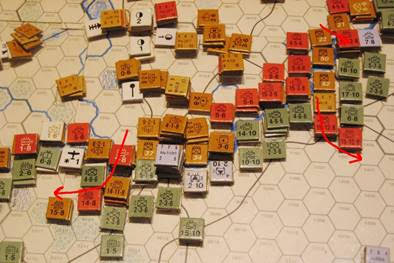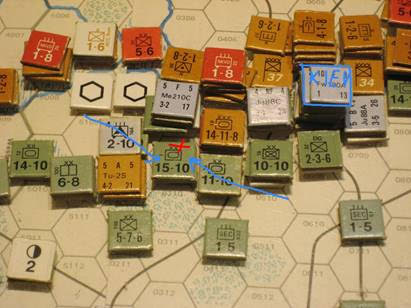Turn Report
Losses inflicted on the Axis forces this turn are unprecedented as the Axis Front in the Ukraine collapses completely and Soviet forces overwhelm troops who are too weak to resist or too slow to escape their onslaught.
Partisans: No activity
Arctic Front: (3 attacks) The Amphibious landings at Alta face fierce resistance from shore batteries and are forced to land further from the city than planned. The North-eastern most is displaced into its own advancing front line while the Southernmost force is forced onto a narrow peninsular 20 miles from the planned landing zone. (Ok, I confess, I missed the rule about no landings adjacent to enemy ports in planning. Decided to proceed anyway rather than scrap the landings as this adds some drama and is not an unprecedented occurrence)
On land the broad front advance along the coast road extending 100 miles inland continues and eliminates 3 more regiments/brigades.
Leningrad front: (8 attacks). In the north of this front the attack South of Konigsberg turns through 90° and drives directly South ripping a hole in the German lines. Recon elements of the 2th mech corps reach the outskirts of Danzig but are recalled as Soviet units, still respectfull of the striking power of the Panzers, take a more defensive stance. They content themselves with isolating a single hex of German front line. West of Lotzen a Panzer Grenadier and infantry cadre are eliminated and north of Bialystok a 14-10 Panzer is cardred by direct assault. Whilst this is damaging Axis forces are content that the main drive through the town has been stopped and that the isolated Soviet cardres have been abandoned and will surely be eliminated in August.
A weak infantry/police screen in front of Breast-Litovsk is no match for the advancing Soviet forces who eliminate them and advance another 16 miles towards the former fortress.
Moscow front (6 attacks): The retreat of German mechanised units last turn has exposed the few remaining pockets of infantry to encirclement and annihilation with four infantry divisions succumbing to attacks. In addition, and more distressing, the stack of two Panzer Divisions (14-10 and 13-10) trapped southwest of Kiev is annihilated. Only a thin intermittent screen of retreating Panzer divisions and Panzer grenadier units plus various police and security guards are left between the southern edge of the Pripet and the Rumanian border.
Stalingrad front (12 attacks): The high number of attacks is somewhat misleading as many of these against individual police units and cardres caught in the open by the advancing Soviet hoards. Many attacks are resolved without the use the dice as the high odds and surrounding ZOCs ensure elimination without chance of loss to the attacker.
The retreating units falling back on Odessa are surrounded but not quite isolated by Mech and Tank units driving South West and inserting themselves between Rumanian border and the remains of Army Group South. The trapped units are resentful of the Rumanian forces which simply watch from across the Bessarabian border. Urgent diplomatic missions are sent by Berlin to ensure the solidarity of the Axis Allies and ensure loyalty. At the same time secret Soviet overtures have been made to the Rumanians with a view to seeking early surrender. As a result, Soviet forces are ordered not to cross the border into the country until the Rumanian position is made clear. The Rumanians decide to remain loyal to the German allies but this could easily change when the Soviets cross the borders in force.
The Forgotten Front: On the sand spit in the Crimea the remining Rumanian cadre final succumbs to an attack from 3 Soviet divisions. There is no one left to award them any medals for their unprecedented resistance.
Air Combat: Little change from previous with minimal losses on both sides. The Soviets increasing numerical superiority on the ground however frees up aircraft for other duties and many Harassment missions are flow again this turn to restrict Axis retreats and reduce their ability to shift the panzers to combat the breakout south of Konigsberg.
Combat Report
Many records are broken this turn in respect of Soviet Overruns and Axis combat losses
Overruns = 13, Attacks = 29
Losses:
Axis:
Forts = 14 (8 incl abandoned)
German: Isolated = 58, Un-Isolated = 74, 1x pos AA, 1x Air, 1x Air on ground.
Rumanian: Isolated = 2, Un-Isolated = 4
Hungarian: Isolated = 14, Un-Isolated = 10
Eastern: Isolated = 7, Un-isolated = 4
Totals: Isolated = 81. Un-isolated = 92. Total All Losses = 173
Soviet = 19, 2x Air
Combat Ratio Jul II ‘44: Axis/Soviet = 173/36 = 4.8










